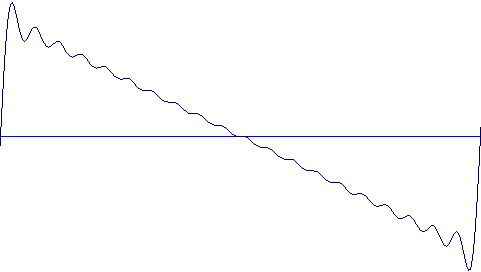Timbre recognition
With timbre, we mean tone colour, for example the type of sound produced by a particular instrument. For acoustic instruments, we would normally learn to distinguish the timbre of e.g. a cello from the timbre of a trombone by repeated listening, musical examples, and also from the knowledge of the physics and visual appearance of the instruments. With electronic sounds, we oftentimes do not have a physical or visual representation, so we need to rely more heavily on the purely auditive cues. We can say that timbre multidimensional, as it is determined by many independent factors: Which harmonic overtones are present, their internal balance, vibrato, inharmonic or noise components, evolution of the different sonic components over the duration of an event (a "note") etc. As our departure point we will use some classic electronic waveforms, as they can be very cleary defined and also represent clearly different timbres. These waveforms can be constructed from a set of harmonically related partials, which gives us an excuse to revive some terms to describe these too.
The fundamental, or fundamental frequency of a timbre, is the frequency that determines the perceived pitch. We may have timbres with a missing fundamental, where the combination of harmonics suggests that there must be a fundamental frequency even if the sound does not have any energy at that frequency. The fundamental frequency is in many cases the lowest frequency present in a timbre, but we may in spacial cases have subharmonics, extending from the fundamental and downwards in the spectrum. Lets now mention that the fundamental is counted as the first harmonic, and that the harmonics are related to the fundamental by integer ratios. The second harmonic is then to be found at twice the fundamental frequency, i.e. one octave up. The third harmonic is then found at three times the fundamental frequency, one and a half octaves up.
Sine wave
The sine wave is the simplest electronic tone, its timbre is made up of one frequency component, the fundamental.

Saw wave
The saw wave ideally contains all harmonics. In the digital domain it should only contain all harmonics up to the Nyquist frequency. The amplitude of the harmonics can be defined as 1/N where N represent the harmonic number. For example the amplitude of the second harmonic is 1/2 the amplitude of the fundamental, the amplitude of the third harmonic is 1/3 of the amplitude of the fundamental and so on.

Square wave
The square wave is an artificial waveform, containing only odd harmonics. The amplitude of the harmonics can be defined as 1/N similar to the case of the saw wave, except that we do not have any energy at all for even numbered harmonics.

Triangle wave
The triangle wave is also artificial, in that it contains only odd harmonics (like the square wave). Naturally occuring sounds will have some energy in both odd and even harmonics. The ampltude of the harmonics in this case is defined as 1/(N*N), so that the falloff in ampltude is significantly steeper than what we see (hear) in the square wave. The phase of the harmonics is also different, in that every other present harmonic (that is the 3rd, 7th, 11th and so on) has a 180 degree phase shift, literally turning it's shape upside down.
